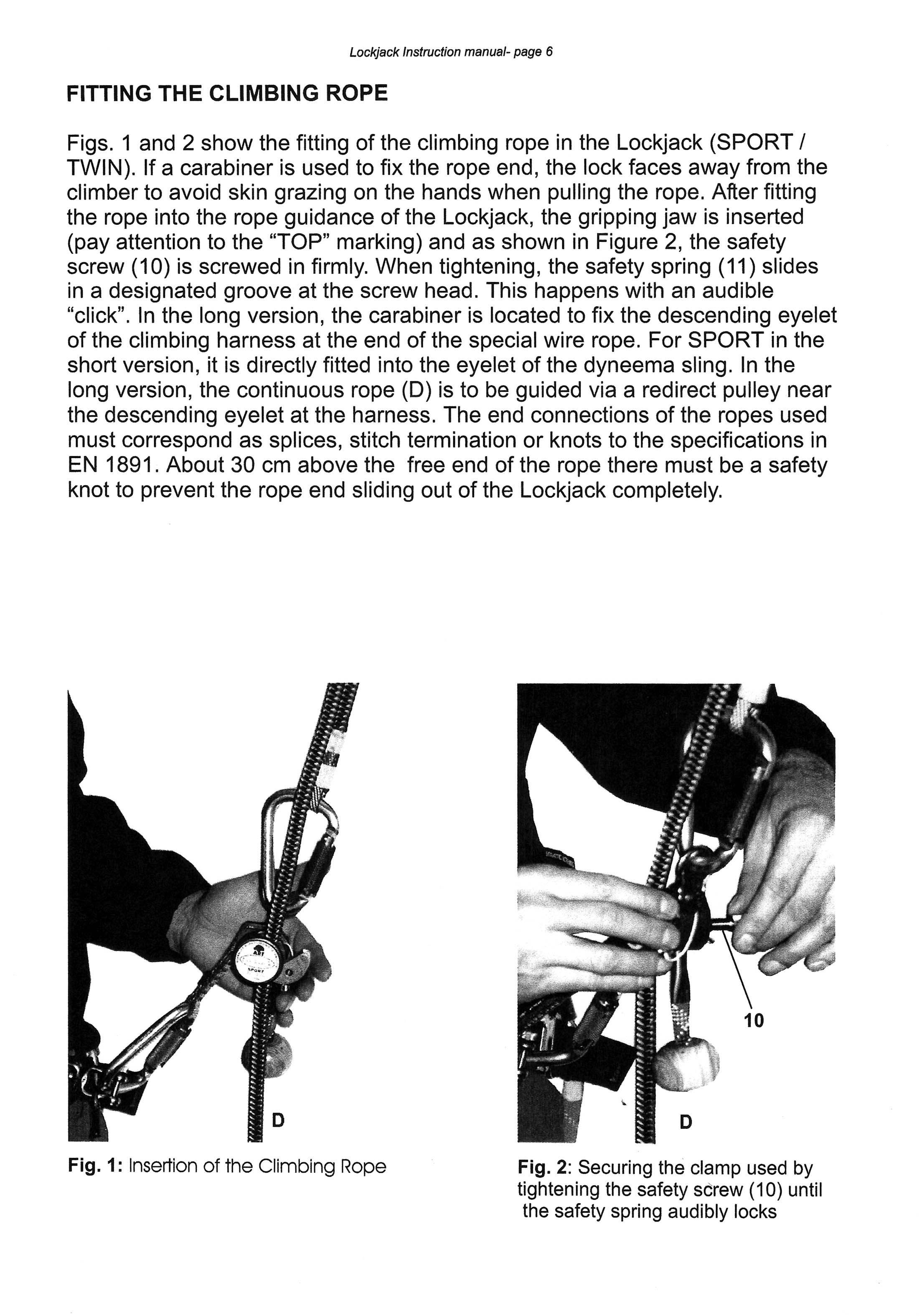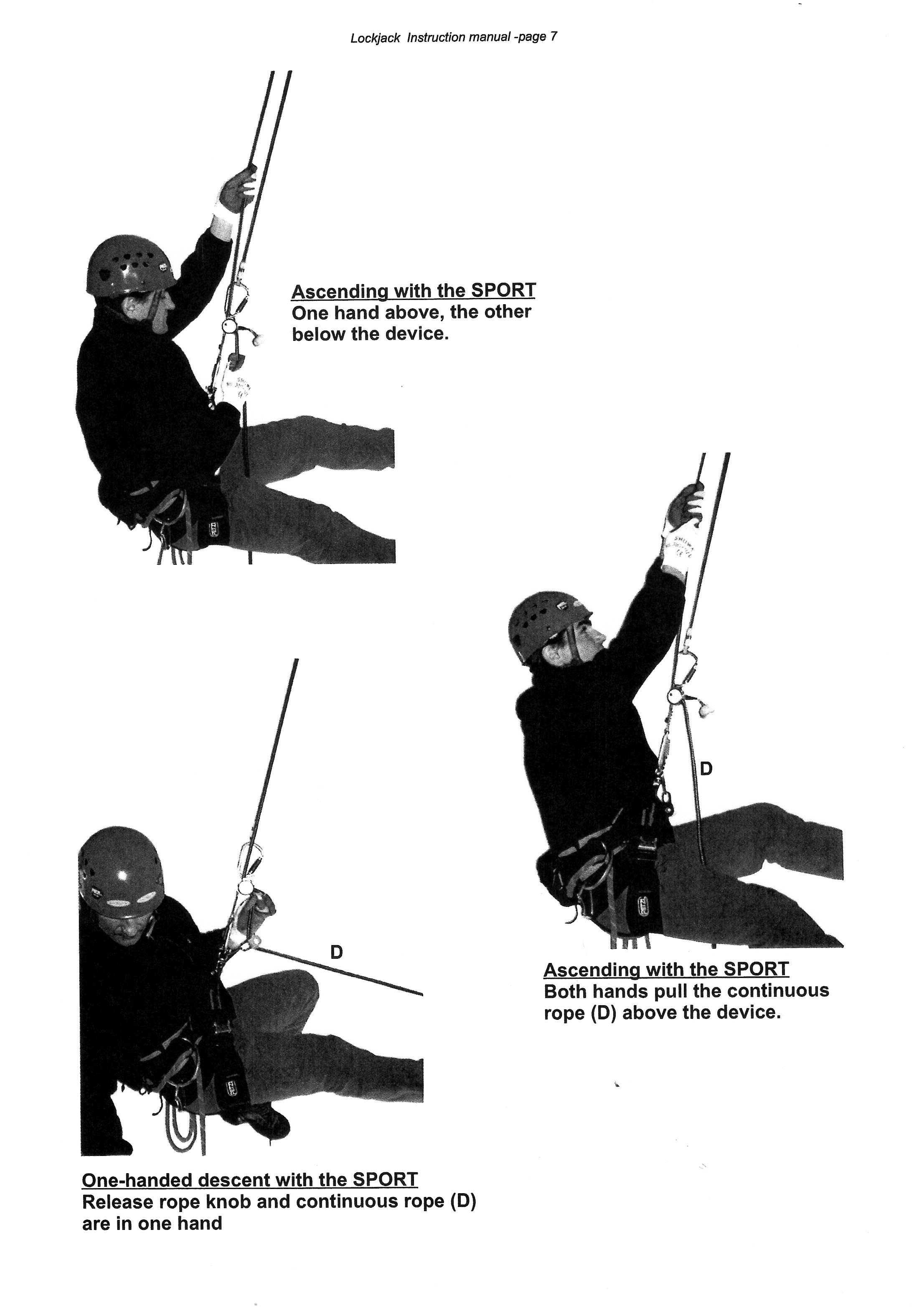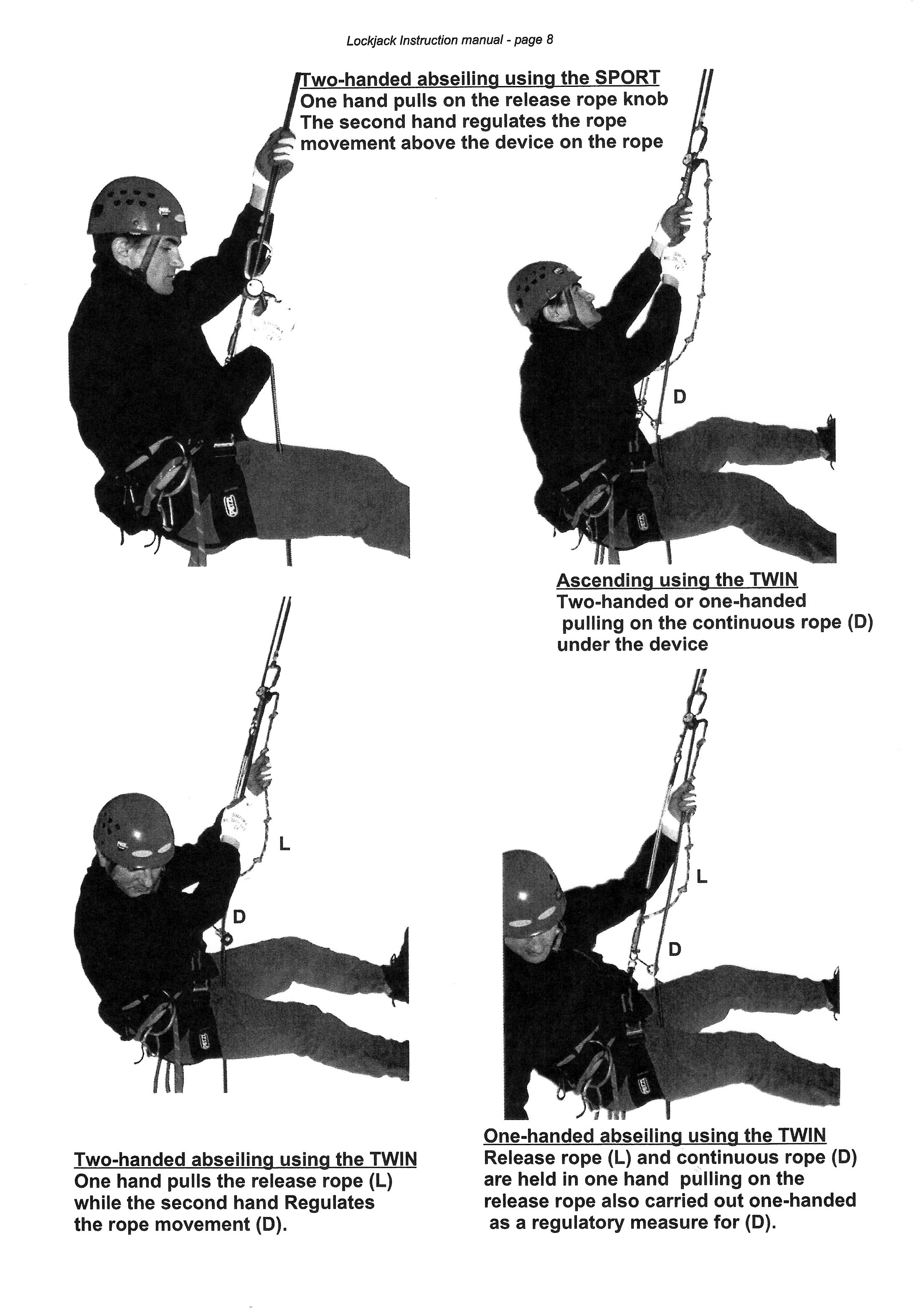Overview
[ Top
| Version B
| Return to Most Misc.
]
Version A
(#829, 2624)
Technical Details
I acquired my Lockjack Sport, Version A from Robert Jones in 2005. I acquired another in 2017 as part of Bob Thrun’s collection.
The Lockjack Sport consists of an aircraft aluminum body and
a wooden knob attached by a 70 mm. length of 12 mm. kernmantle.
The knob diameter is 42.5 mm. and the height is 36 mm., with a 30 mm.
diameter, 14 mm. deep recess in the base. The knob attaches to
the kernmantle by the simple expedient of melting the end of the
rope. The other end of the kernmantle is crimped into a 13.3 mm.
diameter, 40 mm. long brass tube pressed into the main body of
the Sport.
The remaining description is somewhat complicated since most
of the pieces are irregular. The body consists of two main pieces"
(1) a 28.3 mm. thick, 45.2 mm. diameter cylinder with two small
projections, and (2) a 44.8 mm. diameter, 19 mm. thick cylinder
bolted to the right side of the first. The first cylinder has
the following features:
- A 13.2 mm. slot milled across the top and down the front,
10 mm. from the left side.
- The projections point upward and slightly forward. These
are drilled for a 6 mm. cap screw that supports a pivoting arm
with a 15.50 mm. eye. The arm is 60 mm. long and 8 mm. thick along
most of its length, widening at the base to fit the slot. There
is a small oil hole in the base of the arm that passes down to the
pivot.
- A second cap screw and washer keep the pivot cap screw from
backing out.
- A cap screw, bushing and nut hold a 20 mm. by 6 mm. round clevis
at the top rear of the cylinder.
- A knurled pin acts as a pivot for the cam to be described
later. (The cam fits into the second block). The knurled pin
is 58. mm. long with a 47.8 mm. active length. From the knurled
knob, the active length consists of (1) a 1 mm. groove, (2) an
0.5 mm. shoulder, tapered toward the free end, (3)15 mm. of 7 mm.
x 1 mm. thread, (4) a 2 mm. gap, (5) another 7 mm. length of thread,
and (6) the remainder as a smooth 6.3 mm. cylinder.
- A cap screw in the axis of the main cylinder supports a 1 mm.
spring wire. One end fits in a small hole near the cap screw,
the other extends beyond the cylinder perimeter, where it bends
back and up into a 1.5 mm. wide slot cut in the lower rear. This
spring acts in the 1 mm. groove in the knurled pin to keep it
from coming out inadvertently.
- The brass tube holding the kernmantle fits into a hole in
the base of the first cylinder.
The second cylinder is cut away on the side bolted to the first,
forming a 15.2 mm. wide, 30.5 mm. deep rope groove on the rear of
the device. The cam is a chordal segment of a circular disk, cut
away on the flat side and the top corner with a concave surface
to match the rope diameter. The second cylinder is attached to the first cylinder with two recessed hex-socket cap screws.
My Lockjack Sport has a sticker on the right side with a tree
logo, "ART" underneath, and "ADVANCED ROPECLIMBING
TECHNOLOGY" above. A sticker on the front has "TOP"
between two up-pointing arrows, "Lockjack" and "PAT
PEND" within an ellipse, "SPORT," "MADE IN
GERMANY," and "CE0299." A sticker on the cam has
two up-pointing arrows and the word "TOP." The two cap
screws holding the cylinders together are marked is marked "CS,"
"A2," and"70."
The Lockjack Sport is obviously related to Buckingham
Lockjack. The eBay seller provided the following description:
LOCK JACK SPORT for use on 1/2in arborist
… The Lock Jack is a precision mechanical device that allows
ascending and descending in one unit. This very simple but secure
rope brake works similar to a climber’s friction hitch by pinching
line when weight is applied. Unlike a friction hitch, Lock Jack
allows incoming line to enter freely and nearly friction-free.
Like its cousin the Petzl
I’D, Lock Jack uses a clean aluminum
surface to create friction instead of the standard fiber unfriendly,
rope on rope method. Unlike the Petzl
I’D, the Lock Jack allows incoming
slack to virtually fall through the device during ascent or while
limb walking. Both mechanical devices incorporate a handle that
regulates grip to the line. We consider the Lock Jack more sophisticated
than other options but suited more towards professional climbers,
due to its high level of sensitivity. In the latter half of 2000
the German inventor Hubert Kowalewski redesigned the original
Lock Jack and released two versions aptly named the TWIN, a small
twin to the earlier model and the SPORT, a compact and fast reacting
version that remains close to the harness. The basis of the redesign
was to make Lock Jack longer lasting by incorporating a small
clutch-like device that can be easily replaced upon wear (100
to 500 hours). Surface erosion to mechanical devices such as
this is an issue greatly dependent on the amount of dirt within
each climbers environment as well as the speed at which one descends.
For this reason we highly recommend utilizing clean rope along
with a friction saving device during use. The Lock Jack TWIN
is much like its predecessor in that there is a long tether that
keeps the device a few feet ahead of the worker. This version
allows rapid hand-over-hand ascent by pulling rope out from behind
the device as it magically advances ahead. The Lock Jack SPORT
requires only 10 to 15 feet of rope weight below before really
showing its stuff. Once the climber is a thrust or two above
the ground, gravity drops line through the sport like water down
a drain. Once aloft, the climber can move through thick canopy
with the SPORT virtually unattended until there is need for more
line. Most climbers will prefer the sport for its simplicity,
low profile and supreme sensitivity. Both versions of Lock Jack
are CE certified (the European standard) and meet all the strength
requirements of ANSI. Two carabiners of choice are required for
attachment to your harness along with arborist grade 1/2 inch
(11.5mm) climbing line … with an eye spliced in one end.
I'm not Tarzan, and leave serious evaluations to
a real Tarzan who knows exactly how to use
the Lockjack Sport in arboreal pursuits. Although I have the manual and understand the double rope techniques for ascending and descending, it is not obvious to
me that the Lockjack Sport will reliably grip
if I were to climb a plant and Earth’s gravity suddenly concluded
that I was a ground animal. As for myself, I'll stick to the safety
of caves & cliffs.
Earlier models had a sewn webbing support line instead of the pivoting arm, much like the one on my Lockjack Twin.
[ Top
| Version A
| Return to Most Misc.
]
Version B
(#2753)
Technical Details
I acquired my Advanced Ropeclimbing Technology Lockjack Sport, Version B from Daily Discounts & Pawn Shop in 2019.
Version B is mechanically almost identical to Version A (with some minor dimensional changes that are within normal machining tolerances), so I will put the description in gray and indicate the changes in black text:
The Lockjack sport consists of an aircraft aluminum body and
a wooden knob attached by a 70 mm. length of 12 mm. kernmantle.
The knob diameter is 42.5 mm. and the height is 36 mm., with a 30 mm.
diameter, 14 mm. deep recess in the base. The knob attaches to
the kernmantle by the simple expedient of melting the end of the
rope. The other end of the kernmantle is crimped into a 13.4 mm.
diameter, 45 mm. long brass tube pressed into the main body of
the Sport.
The remaining description is somewhat complicated since most
of the pieces are irregular. The body consists of two main pieces"
(1) a black 27.8 mm. thick, 44.4 mm. diameter cylinder with two small
projections, and (2) a red 44.4 mm. diameter, 19 mm. thick cylinder
bolted to the right side of the first. The first cylinder has
the following features:
- A 13.1 mm. slot milled across the top and down the front,
10 mm. from the left side.
- The projections point upward and slightly forward. These
are drilled for a 6 mm. cap screw that supports a pivoting arm
with a 15.50 mm. eye. The arm is 60 mm. long and 8 mm. thick along
most of its length, widening at the base to fit the slot. There
is a small oil hole in the base of the arm that passes down to the
pivot.
- A second cap screw and washer keep the pivot cap screw from
backing out.
- A cap screw, bushing and nut hold a 20 mm. by 6 mm. round clevis
at the top rear of the cylinder.
- A knurled pin acts as a pivot for the cam to be described
later. (The cam fits into the second block). The knurled pin
is 58. mm. long with a 47.8 mm. active length. From the knurled
knob, the active length consists of (1) a 1 mm. groove, (2) an
0.5 mm. shoulder, tapered toward the free end, (3)15 mm. of 7 mm.
x 1 mm. thread, (4) a 2 mm. gap, (5) another 7 mm. length of thread,
and (6) the remainder as a smooth 6.3 mm. cylinder.
- A cap screw in the axis of the main cylinder supports a 1 mm.
spring wire. One end fits in a small hole near the cap screw,
the other extends beyond the cylinder perimeter, where it bends
back and up into a 1.5 mm. wide slot cut in the lower rear. This
spring acts in the 1 mm. groove in the knurled pin to keep it
from coming out inadvertently.
- The brass tube holding the kernmantle fits into a hole in
the base of the first cylinder.
The second cylinder is cut away on the side bolted to the first,
forming a 15.2 mm. wide, 30.5 mm. deep rope groove on the rear of
the device. The cam is a chordal segment of a circular disk, cut
away on the flat side and the top corner with a concave surface
to match the rope diameter. The second cylinder is attached to the first cylinder with two recessed hex-socket round-head screws.
The front is printed with the ART logo. The rear is printed with "EN 358," a scanner code, and a book-with-an-"i" icon. The left side rear (black) cylinder is printed with "ART," "Lockjack Sport," "01.12 04 397," and "CE 0123." The red cam is printed with two carets ("^") above each other, "11/12," and "TOP." The left side front (red) cylinder is printed with two carets ("^") above each other and "TOP." The pivoting arm has the "ART" printed on one side and "L 12" on the other.
Version B is functionally identical to Version A, but the color scheme makes it look like a far nicer product. Looks don't hurt, but in this case they do not affect function.
[ Top
| Version A
| Version B
]





